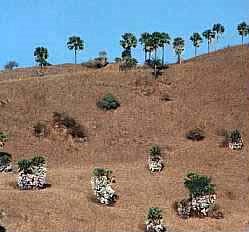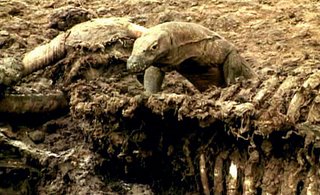 The first thing to tantalize the senses is the incredible scenery, gloriously free of any sign of human presence. The park headquarters are hidden discreetly at the foot of a hill, and that's it.
The first thing to tantalize the senses is the incredible scenery, gloriously free of any sign of human presence. The park headquarters are hidden discreetly at the foot of a hill, and that's it. The rest of the island is pure wilderness through and through - a landscape clothed in dry grasslands and tall stands of Lontar Palm. The patches of scrubland forest also host an array of brightly hued epiphytic orchids. With a location like this, I was looking forward to finding dragons of a 'wilder' temperament...
The rest of the island is pure wilderness through and through - a landscape clothed in dry grasslands and tall stands of Lontar Palm. The patches of scrubland forest also host an array of brightly hued epiphytic orchids. With a location like this, I was looking forward to finding dragons of a 'wilder' temperament... Walking alone, with just the company of a forest ranger, its easy to feel the isolation and remoteness of this 20,000 hectare island. The landscape is awesome - a seamless montage of sky, savannah and sea. But to find actual wildlife you've got tear your gaze away from the grand vistas and search closer to the ground.
Walking alone, with just the company of a forest ranger, its easy to feel the isolation and remoteness of this 20,000 hectare island. The landscape is awesome - a seamless montage of sky, savannah and sea. But to find actual wildlife you've got tear your gaze away from the grand vistas and search closer to the ground.Its not long before the sounds of frantic scurrying and scrabbling among the rocks and boulders reveal the presence of juvenile dragons, rushing for cover. Dragons have famously earned themselves a reputation as a cannibalistic species - and rightly so, although most victims end up being the youngsters who accidently get in the way of an adult during its feeding frenzy.
Juvenile dragons have come up with a novel 'cannibal anti-deterrent'. They smear themselves in the faecal matter of fallen prey. Even catholic eaters like Komodo Dragons, with their wide-ranging menu, still draw the line when it comes to faecal matter...
 But younger dragons don't even risk life on the ground. From the moment they hatch, they ascend into the trees and remain there for the first year of their lives.
But younger dragons don't even risk life on the ground. From the moment they hatch, they ascend into the trees and remain there for the first year of their lives. In contrast with the dreary grey hides of the adults, young dragons are actually quite colourful creatures. Their initial stripes - a disruptive pattern that helps to break up the shape of their bodies in the surrounding habitat - gradually give way to a coloration of rusty reds and dull greens in adolescence.
In contrast with the dreary grey hides of the adults, young dragons are actually quite colourful creatures. Their initial stripes - a disruptive pattern that helps to break up the shape of their bodies in the surrounding habitat - gradually give way to a coloration of rusty reds and dull greens in adolescence.
Dragons' lair: the burrows from which
hatchling dragons emerge into the world
As soon as I got used to the telltale signs of their presence, it was evident that these dragons-in-the-making were quite well distributed throughout the island's forests and rocky hillsides. We even spotted one chasing down and making quick work of a skink - young dragons are far more active in pursuit of their meals, in complete contrast to their bigger siblings...
 Crossing an open valley, occupied by a small herd of wild (or rather feral) horses in the distance, and a larger group of huge water buffalo, we came across the first sign of a Komodo Dragon attack.
Crossing an open valley, occupied by a small herd of wild (or rather feral) horses in the distance, and a larger group of huge water buffalo, we came across the first sign of a Komodo Dragon attack.Lounging in a pool at a distance from the main herd and shaking its head frantically to keep away a cloud of flies, was an old buffalo. One of its forelimbs had been fractured and bore a severe bite mark - a sure sign of a dragon ambush. The buffalo was obviously easing its discomfort by keeping the wound submerged in the water. The ranger reckoned that the animal had less than 24 hours to live.
And that about sums up the hunting technique of adult dragons. Their saliva harbours a potent cocktail of virulent bacteria, the production of which dragons actively promote by feeding on carrion. New studies have revealed that the reptiles actually pierce their own gums when tearing into flesh with their serrated teeth, thereby providing a further breeding ground for bacteria. So anything that is unfortunate enough to be bitten by a dragon is doomed, through septicaemia. It takes anything from a few hours to a couple of days for the blood poisoning to do its work - while the dragon lingers close-by, waiting for its dinner.
I actually witnessed this technique in action while filming a group of Long-tailed Macaques feeding in the fronds of a tall Lontar Palm (Borassus flabellifer). The ranger and I were parked out on a dry river bed, and while I was trying to find the monkeys through my camera lens, something rushed past me. We both swung around to see a Rusa Deer bounding over the steep river embankment. We realised a dragon was on its tail - and just as the deer was about to clear the embankment, the dragon lunged for its hindleg and took a bite.
The deer broke free; dragon at its heels but slowing noticeably. But the damage had been done. My ranger told me that all the dragon had to do now was follow the blood trail left behind by the deer, and then sit back and wait. How's that for the ultimate energy-efficient hunt!
With a hungry dragon around, we moved away and cut through the forest to get to another clearing. And I was met with a scene of total devastation...
 A couple of sub-adult dragons were crawling over the decaying remains of a buffalo. The lion's share had already been taken by adults, and now that they had retreated to sleep off their meal (they are capable of consuming around 80% of their own body weight in one sitting), the younger ones had come in to finish off whatever remained. The buffalo had literally been stripped clean - but to watch the two reptiles dig in excitedly, there was obviously more to be had here.
A couple of sub-adult dragons were crawling over the decaying remains of a buffalo. The lion's share had already been taken by adults, and now that they had retreated to sleep off their meal (they are capable of consuming around 80% of their own body weight in one sitting), the younger ones had come in to finish off whatever remained. The buffalo had literally been stripped clean - but to watch the two reptiles dig in excitedly, there was obviously more to be had here. During the course of half an hour, they systematically took the carcass apart, hauling entire legs away as if they weighed absolutely nothing.
During the course of half an hour, they systematically took the carcass apart, hauling entire legs away as if they weighed absolutely nothing.The dragons were so preoccupied that I was able to sit on the ground just about a hundred metres away, and film to my heart's content.
The ranger assured me that we were in no danger - dragons preferred their meat 'over-ripe'...
We returned to this clearing two days later, when I was due to depart from Rinca and join the rest of the crew back at Komodo Island (they had been filming coral reefs that fringed the island - and a dragon out at sea - but that's another story).
All that was left of this scene was a darkened stain on the ground, where the buffalo had fallen, just three days earlier...
Finally I had witnessed the true nature of the Komodo Dragon; exhibiting all the hallmarks of its grand, hundred million year legacy.

7 comments:
Varanus salvator does co-exist with Varanus komodensis - but only on one island. The water monitor on the whole avoids any contact with the larger dragons, although we did see a few individuals in the coastal mangroves in Rinca - think they probably limit themselves to this habitat since dragons favour open ground
wow your whole account reminds me of the Komodo chapter from Douglas Adams and Mark Carwardine's book "Last Chance to See"
Except this is 2 decades later with much vivid images! WOW!
Thank you!
There is a blog called Last Chance to See that keeps track of the endangered species mentioned in the book.. I wonder if they'll be interested in this (if they haven't link it already!) hehe will drop them a note
FYI, the blog I mentioned is actually called Another Chance to See and here's the URL
http://anotherchancetosee.blogspot.com/
I've dropped them a note :)
Cheerios!
Yes, I'm VERY interested. I've linked to both posts from Another Chance To See.
Nice job Chirath.
Thanks very much Monkey and Gareth - I will put a link up to Another Chance to See as well.
I greatly enjoyed reading your article. I hope also to one day go and see the dragons of Komodo Island.
Thanks for reading, Shadowmancer - hope you get the chance to go to Komodo soon!
Post a Comment